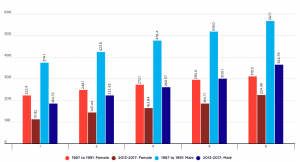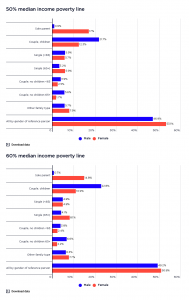High levels of poverty among households reliant on income support payments are due in part to the level of these payments, which generally sits below the poverty line. A household reliant on income support payments usually needs extra income such as part-time earnings to avoid poverty. How much extra income is needed depends on the difference between the payments and the poverty line, and also on housing costs (which are taken into account in this research).
This table compares the standard maximum rates of major income support payments with before-housing poverty lines in 2015-16 and 2017-18. In this case, the gaps between maximum payment rates and poverty lines are based on a cameo family type with no private income, so they do not take account of the private incomes and housing costs of families in the ABS income survey sample.
2017-18
There are large gaps between maximum single rates of Newstart Allowance and Youth Allowance and the poverty line (at $117 and $168 a week respectively). Allowance payments such as these are indexed to the Consumer Price Index (CPI) only and not wages, so they generally grow more slowly than community living standards. In 2017-18, the maximum single rate of Newstart Allowance (together with maximum Rent Assistance and Energy Supplement) was $340 per week.
Youth Allowance for single young people living away from the parental home (up to 25 years old if studying fulltime) was $51 a week less than Newstart Allowance, at $289 per week, reflecting the view that young people can rely on parental support, despite having been assessed as financially independent. This assumption extends to full time students even up to 64, who receive Austudy or Abstudy Payment at the same rate as Youth Allowance.
Pension payments hover just below the poverty line. In 2017-18, it was $10 less than the poverty line for a single person receiving the pension, and $2 less than the poverty line for a couple receiving the pension.
2015-16
There are large gaps between maximum single rates of Newstart Allowance and Youth Allowance and the poverty line ($105 using 50% of median income poverty line and $148 a week using 60% of median income poverty line respectively). Allowance payments such as these are indexed to the Consumer Price Index (CPI) only and not wages, so they generally grow more slowly than community living standards. In 2015-16, the maximum single rate of Newstart Allowance (together with maximum Rent Assistance and Energy Supplement) was $328 per week.
Youth Allowance for single young people living away from the parental home (up to 25 years old if studying fulltime) was $43 a week less than Newstart Allowance, at $285 per week, reflecting the view that young people can rely on parental support, despite having been assessed as financially independent. This assumption extends to full time students even up to 64, who receive Austudy or Abstudy Payment at the same amount as Youth Allowance.
Government payments (including Family Tax Benefit) for sole parent families relying on Parenting Payment Single are $17 a week below the poverty line, where the family rents privately and has two school-age children. Before 2009, Parenting Payment Single was paid at the same rate as other pensions, but this payment was excluded from the increase in single pensions in 2009.
Sole parents not in paid work whose youngest child is eight years of age or over receive the single parent rate of Newstart Allowance, which was $82 a week less than Parenting Payment Single in 2015. A sole parent family on Newstart Allowance that rents privately and has two school-age children, receives $105 a week less than the poverty line.
Social security allowance payments for couples are generally below the 50% line, but closer to it in proportional terms. Newstart Allowance for a couple without children is $85 a week below the poverty line, and (together with family payments and Rent Assistance) it is $150 below it for those with two school-age children.




